|


SENIOR
MILITARY COMMANDS AND COMMANDERS AT QUARRY HEIGHTS
ANCON
HILL HISTORY - OCCUPANTS
|
Quarry
Heights -- History (Continued)
ADDITIONAL CONSTRUCTION IN THE EARLY
YEARS
A large L-shaped frame structure
Headquarters building (at the south end of the post) and a supply/
administrative/barracks building were hastily erected in 1916 constructed
from salvaged materials.
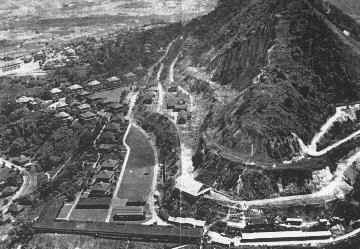
QUARRY
HEIGHTS pre-1930 -- Constructed on two ledges carved out of Ancon Hill.
The original headquarters building (Panama Canal Department) was
constructed in 1916 (in left
lower foreground of photo and map). [U.S.
Army photo - Quarry Heights Transfer Ceremony brochure] |
|
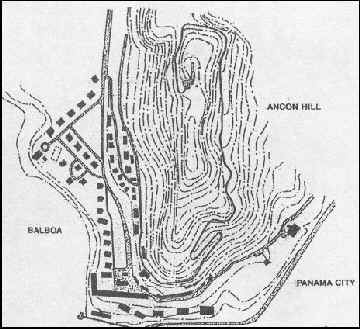
Map shows the lower
area of Quarry Heights facing 4th of July Avenue was virtually
unused pre-1930s.[Quarry
Heights pamphlet -- U.S. Army |
|
| Building 84 was erected near the Command
Headquarters building in June 1919 as the post library and motion picture
hall. Although the origin of this structure is not known, its era of
construction and its design and function indicate that it might have been
moved from one of the Canal construction era communities where it had
served as either a theater or a church. With the exception of
houses, it was the oldest building still actively used at Quarry Heights
through 1997 and after transfer to Panama in 1998. It was renovated in 1994 as the Southern Command's Conference Center (with post
office remaining in the rear part). The renovated center was named Ivan
Perez Conference Center in honor of the first of the 23 U.S. military
soldiers killed by hostile fire during Operation Just Cause December 20,
1989. |
|
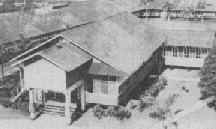
BUILDING 84 around
1935. Original Command Headquarters building on left and back sides of
84. [From
History of Quarry
Heights -- U.S. Army pamphlet] |
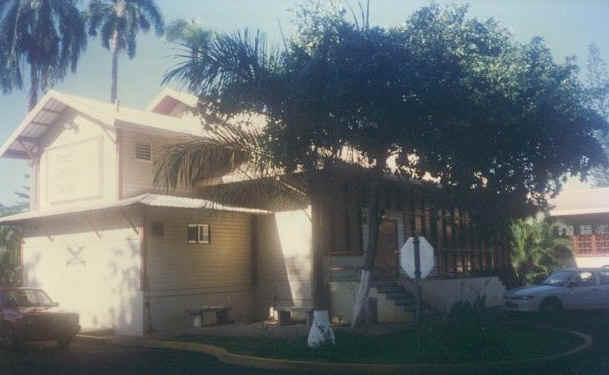 Building 84 in 1990s as the Ivan
Perez Conference Center and (on right side) post office. [Photo
by WHO Sept 1997]
Building 84 in 1990s as the Ivan
Perez Conference Center and (on right side) post office. [Photo
by WHO Sept 1997] |
HOUSING FROM FORMER CONSTRUCTION
CAMPS
| As the need arose for housing military
personnel and their families at Quarry Heights, old Isthmian Canal
Commission wooden framed houses for senior grade Canal construction
officials, which had been transferred to the military, were dismantled
from Canal construction camps of Culebra and Empire (across the Canal),
transported by rail and barge, and re-erected at Quarry Heights. Houses were moved
as the need for them arose. One of the first such buildings to be moved to
Quarry Heights was Quarters 1, the official residence of the Commander in
Chief, erected on its present location in mid-1915. The Army erected 24
residences, along with other buildings, between 1915 and 1919 (Quarters 2
through 7 for the Command officers and Quarters 9, 20 and 21 for Provost
officers at the south end of the post in 1915; in 1916 Quarters 11, 13,
14, 16 were added; and in 1918 Quarters 8, 10, 18, 22, and 23 were added). Others
followed within the next few years. |

QUARTERS 1 (shown here in
the 1990s), the residence of the Commander
in Chief,
was erected at Quarry Heights in 1915. Over
the next eighty-two years, it had 38 official residents,
from the Commander (one-star) of U.S. Troops in Panama, Brigadier General
Clarence R. Ediwards, to the Commander-in-Chief (four-star) of the
U.S. Southern Command. General and Mrs. Wesley Clark, the last
occupants. [U.S.
Army photo - Quarry Heights Transfer Ceremony pamphlet, Jan 1998] |
|
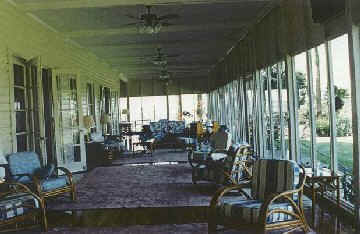 QUARTERS 1 (1990s) -
front porch/main entrance [U.S.
Army photo - Quarry Heights Transfer Ceremony pamphlet, Jan 1998]
QUARTERS 1 (1990s) -
front porch/main entrance [U.S.
Army photo - Quarry Heights Transfer Ceremony pamphlet, Jan 1998] |
|
|
World War I brought to light the
strategic importance of the Panama Canal and the U.S. Military presence in
the Canal Zone and spurred development of Quarry Heights as the
headquarters for the Army's new Panama Canal Department. Under this
command (established July 1917 as a geographical Army command reporting to Fort
Jay under the Eastern Department of the U.S. War Department in New York) fell the Panama Canal Division and the Coast Artillery
Command, which incorporated all Infantry and Coast Artillery troops on the
Isthmus of Panama. The Coast Artillery guarded the entrances to the Canal
from Forts Sherman, DeLesseps, and Randolph on the Atlantic side of the
Isthmus, and from Forts Amador and Grant on the Pacific side. Infantry
troops at Fort Clayton on the Pacific side and Fort Davis on the Atlantic
side were responsible for defending and protecting the Miraflores, Pedro
Miguel and Gatun Locks. Later, between the two world wars and during World
War II, other military installations were constructed: Fort Kobbe, Albrook
Field (later Albrook Air Force Base), Howard Air Force Base on the Pacific
side, Rodman Naval Station, and Fort Gulick and Galeta
Island on the Atlantic side
|
<<Preceding
Page >>NEXT
PAGE
Site
developed, owned and maintained by
William
H. Ormsbee, Jr. 2005
|
![]() SCROLL
SCROLL